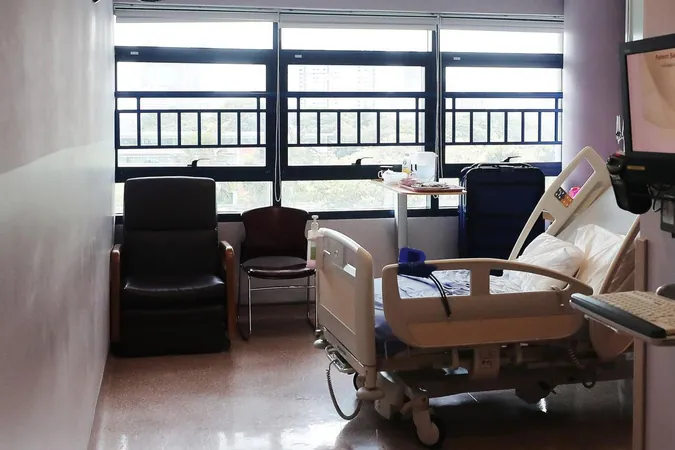
Major Shift in Great Eastern Insurance Coverage Could Impact Your Medical Bills!
2025-01-21
Author: Jia
SINGAPORE
In a surprising move, Great Eastern Life (GE) has dramatically revised the coverage terms for its integrated shield plans (IPs), particularly affecting policyholders who decide to upgrade to higher-class wards for treatment. This significant change has left many customers questioning the rationale behind the new policies and the potential impact on their healthcare costs.
Changes in Coverage
Starting in October 2024, GE policyholders who have a Class A integrated shield plan but choose to receive treatment at a private hospital will now only receive 35% of their medical bills covered, a stark reduction from the previous 70%. This change means that if a Class A IP holder opts for a higher-tier private hospital, they will bear a much greater financial burden than before. Notably, those who stick with treatments in their designated class will continue to receive the original coverage terms.
This restructuring follows a broader trend, as noted by the Ministry of Health (MOH), which revealed that most integrated shield insurers (excluding Raffles Health Insurance) will be adjusting their product offerings in response to evolving healthcare costs and claims experiences. With numerous companies raising their premiums alongside these coverage adjustments, many customers are left feeling the pressure.
Individual Experiences
"Usually we don’t dig deep into insurance details until we have a claim," lamented Ms. Sharon Chong, whose decision to transfer her ailing mother from a public hospital to Mount Elizabeth Novena Hospital resulted in her being caught off guard by GE's changes. “After years of faithfully paying premiums based on certain coverage expectations, it’s shocking to see such a steep drop to 35% without prior notice."
Broader Implications
Alongside the Class A changes, the coverage for Class B1 IP holders will also see substantial cuts. The percentage for private hospital treatments will plummet from 50% to just 25%, while Class A treatment coverage will decrease from 80% to 70%. This could potentially lead to increased out-of-pocket expenses for many patients.
A GE spokesperson highlighted that these changes are intended to align coverage with the rising costs associated with private versus restructured healthcare. This adjustment aims to prevent the unfair cross-subsidisation of expenses incurred by policyholders who opt for more economical hospital services against those choosing pricier private care.
MediShield Life Amendments
The MOH has stipulated that such changes must adhere to specific parameters, including co-pay and deductible requirements. The deductible refers to the portion of medical costs patients must pay before their insurance coverage kicks in, while co-payment is the remaining percentage of the bill that insurance does not cover.
Further compounding these challenges, significant amendments to the MediShield Life framework are set to take effect in April 2024. Under these changes, coverage for medical treatment at private hospitals will decrease from 25% to 10%, Class A ward coverage from 35% to 25%, and Class B1 from 43% to 35%. The MediShield Life Council explained that these adjustments are necessary to better reflect the escalating costs of private care, thereby ensuring a fair insurance environment.
Market Response
In the competitive insurance market, GE's shift has sparked concerns over how remaining insurers might respond in 2025, as they revise their coverage in light of MediShield adjustments. Insurers, including AIA, are poised to evaluate how these developments impact their offerings.
New Initiatives
Interestingly, while GE has reduced its Class B1 coverage for non-subsidised short-stay wards and outpatient treatments, it has also expanded its coverage in certain areas, such as proton beam therapy, significantly increasing the support available to patients.
In a progressive move, insurers have now adopted the Mobile Inpatient Care@Home (MIC@Home) initiative, now covering patients receiving care at home under normal inpatient rates, enabling care delivery in a more comfortable environment for patients.
Conclusion
This massive overhaul of coverage and costs prompts critical questions: Will patients be adequately prepared for these changes? And how can they best navigate the complexities of their health insurance as policies evolve? As consumers encounter these new realities, the importance of understanding your insurance coverage couldn't be more pressing. Keep informed and stay ahead of the changes that directly affect your healthcare choices!




 Brasil (PT)
Brasil (PT)
 Canada (EN)
Canada (EN)
 Chile (ES)
Chile (ES)
 Česko (CS)
Česko (CS)
 대한민국 (KO)
대한민국 (KO)
 España (ES)
España (ES)
 France (FR)
France (FR)
 Hong Kong (EN)
Hong Kong (EN)
 Italia (IT)
Italia (IT)
 日本 (JA)
日本 (JA)
 Magyarország (HU)
Magyarország (HU)
 Norge (NO)
Norge (NO)
 Polska (PL)
Polska (PL)
 Schweiz (DE)
Schweiz (DE)
 Singapore (EN)
Singapore (EN)
 Sverige (SV)
Sverige (SV)
 Suomi (FI)
Suomi (FI)
 Türkiye (TR)
Türkiye (TR)